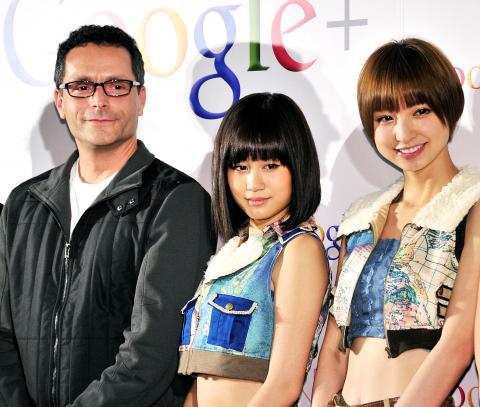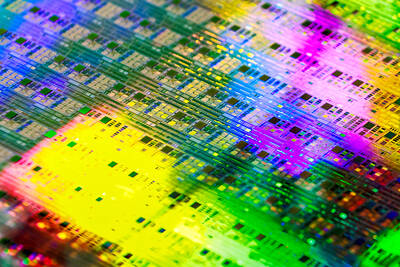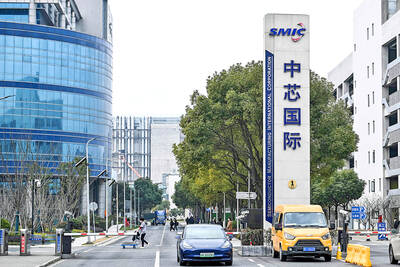Google yesterday began construction of a new data center in Hong Kong, the first of three planned for Asia as the Web giant expands to meet the region’s growing thirst for information technology.
The facility, Google’s first outside the US and Europe, will cost US$300 million and is being built on 2.7 hectares in the Tseung Kwan O industrial estate in Kowloon, the firm said.
“We’re working as quickly as we can [to] get to this facility operational so we can keep up with rapid growth in capacity demand across the region,” Simon Chang, Google’s Hardware Operations manager in Asia, said at the groundbreaking ceremony.

Photo: AFP
“We’re targeting early 2013 to start bringing the facility online,” he said, according to a statement.
Two other data centers — which usually house computer and telecom systems with high security and backup power supplies — are also planned for Taiwan and Singapore.
The firm has said the facility in Taiwan will cost more than US$100 million, but has yet to release any figure for Singapore.
Separately, US telecoms titan Verizon is shunning Google’s nascent smartphone Wallet, saying the technology reaches too deep into handsets for comfort.
Verizon asked the Internet giant not to include the payment feature on new Android-powered Samsung Galaxy Nexus smartphones tailored for the carrier’s network, Google said in response to a reporter’s inquiry.
Verizon spokesman Jeffrey Nelson said that the carrier was not blocking Google Wallet from Galaxy Nexus smartphones, but was “continuing our commercial discussions with Google” regarding including the technology in handsets.
Verizon maintained that its reservations stem from the fact that Wallet requires access to secure chips deep in smartphones.
Google Wallet uses a near field communication (NFC) chip embedded in a phone to allow a user to “tap-and-pay” for purchases at a checkout register equipped with the PayPass system from CitiMasterCard.
Chips essentially transmit credit card details to sensors at checkouts to consummate purchases.
NFC technology is being tested or used in a number of countries already, notably France, but Google Wallet was the first to bring it to the US on a potentially large scale.

NO BREAKTHROUGH? More substantial ‘deliverables,’ such as tariff reductions, would likely be saved for a meeting between Trump and Xi later this year, a trade expert said China launched two probes targeting the US semiconductor sector on Saturday ahead of talks between the two nations in Spain this week on trade, national security and the ownership of social media platform TikTok. China’s Ministry of Commerce announced an anti-dumping investigation into certain analog integrated circuits (ICs) imported from the US. The investigation is to target some commodity interface ICs and gate driver ICs, which are commonly made by US companies such as Texas Instruments Inc and ON Semiconductor Corp. The ministry also announced an anti-discrimination probe into US measures against China’s chip sector. US measures such as export curbs and tariffs

The US on Friday penalized two Chinese firms that acquired US chipmaking equipment for China’s top chipmaker, Semiconductor Manufacturing International Corp (SMIC, 中芯國際), including them among 32 entities that were added to the US Department of Commerce’s restricted trade list, a US government posting showed. Twenty-three of the 32 are in China. GMC Semiconductor Technology (Wuxi) Co (吉姆西半導體科技) and Jicun Semiconductor Technology (Shanghai) Co (吉存半導體科技) were placed on the list, formally known as the Entity List, for acquiring equipment for SMIC Northern Integrated Circuit Manufacturing (Beijing) Corp (中芯北方積體電路) and Semiconductor Manufacturing International (Beijing) Corp (中芯北京), the US Federal Register posting said. The

India’s ban of online money-based games could drive addicts to unregulated apps and offshore platforms that pose new financial and social risks, fantasy-sports gaming experts say. Indian Prime Minister Narendra Modi’s government banned real-money online games late last month, citing financial losses and addiction, leading to a shutdown of many apps offering paid fantasy cricket, rummy and poker games. “Many will move to offshore platforms, because of the addictive nature — they will find alternate means to get that dopamine hit,” said Viren Hemrajani, a Mumbai-based fantasy cricket analyst. “It [also] leads to fraud and scams, because everything is now

MORTGAGE WORRIES: About 34% of respondents to a survey said they would approach multiple lenders to pay for a home, while 29.2% said they would ask family for help New housing projects in Taiwan’s six special municipalities, as well as Hsinchu city and county, are projected to total NT$710.65 billion (US$23.61 billion) in the upcoming fall sales season, a record 30 percent decrease from a year earlier, as tighter mortgage rules prompt developers to pull back, property listing platform 591.com (591新建案) said yesterday. The number of projects has also fallen to 312, a more than 20 percent decrease year-on-year, underscoring weakening sentiment and momentum amid lingering policy and financing headwinds. New Taipei City and Taoyuan bucked the downturn in project value, while Taipei, Hsinchu city and county, Taichung, Tainan and Kaohsiung